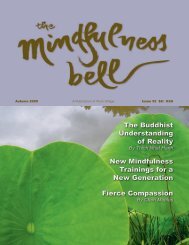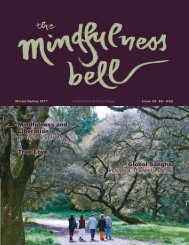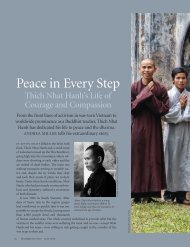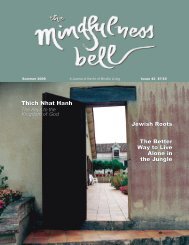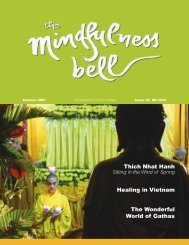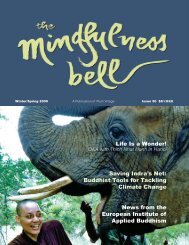J 'Bell - The Mindfulness Bell
J 'Bell - The Mindfulness Bell
J 'Bell - The Mindfulness Bell
Create successful ePaper yourself
Turn your PDF publications into a flip-book with our unique Google optimized e-Paper software.
of happiness and we want the people we love to follow that<br />
idea, but by forcing them to do so, we make them suffer. True<br />
love is always made of true understanding. That is in the<br />
teaching of the Buddha. "Looking with the eyes of compassion"<br />
is an expression from the Lotus Sutra, describing<br />
Avalokiteshvara. When you look at others with the eyes of<br />
compassion, not only do they feel pleasant but you also feel<br />
very pleasant, because understanding and love pervade your<br />
heart. <strong>The</strong> amount of happiness you have depends on the<br />
amount of compassion that is in your heart. Compassion<br />
always carries with it joy and freedom. If you love someone<br />
without understanding, you deprive her of her freedom.<br />
In Buddhist psychology, wesay that our consciousness is<br />
made of two levels. <strong>The</strong> lower level iscalled store consciousness<br />
(alayavijnana), like the basement. We keep all ourseeds<br />
down there,and every timewe or someone else waters a seed,<br />
that seed will sprout and manifest itself on the upper level of<br />
our consciousness, called mind consciousness (manovijhana).<br />
Mind consciousness is like the living room consciousness.<br />
Seedsin the storehouse consciousness manifest themselvesin<br />
the living room consciousness. <strong>The</strong>re are also mental formations.<br />
Mental formations are of 51 kinds, according to the<br />
Northern tradition of Buddhism. <strong>Mindfulness</strong>, loving kindness,<br />
hatred, violence, fear, equanimity, and faithfulness are<br />
mental formations. <strong>The</strong>y manifest themselves on the upper<br />
level of our consciousness.<br />
Our store consciousness is described asthe soil,the earth,<br />
containing many positive and negative seeds. We have to be<br />
aware of all these seeds and their importance. We have seeds<br />
of suffering in us, but not only seeds of suffering. When we<br />
look deeply into ourselves, we may touch the suffering first,<br />
but we should know that there are other seeds present. Our<br />
ancestors have transmitted to us seeds of suffering, but also<br />
seeds of peace, freedom, joy, and happiness. Even if these<br />
seeds are buried deep in our consciousness, we can touch them<br />
and help them manifest.<br />
To touch the seeds of joy, peace, and love within you is a<br />
very important practice. You can ask your friends to do the<br />
same for you. If you love someone, you acknowledge their<br />
positive seeds,and practice touching them every day. Touching<br />
and watering the seeds in one person is a very concrete<br />
practice of love.If you love me, please refrain from watering<br />
only the seeds of anger, despair, and hatred in me.If you love<br />
me, recognize the seeds of joy, gladness, peace, and solidityin<br />
me also and touch them, several times a day. That will help me<br />
grow in the direction of health, joy, and happiness.<br />
To practice mindfulness is to practice selective touching.<br />
Your happiness and suffering depend on you and the people<br />
around you. If they refrain from touching your negative seeds,<br />
if they know theart of touching the positive seedsinyou, you<br />
become a happy person and your suffering will gradually be<br />
transformed by that kind of selective touching.<br />
We learn howto touch the beautyof the sky and the autumn<br />
leaves even if pain and sorrow are still there. If it is difficult, we<br />
have to rely on the presence of a Dharma sister or brother to<br />
help us do so. If one mindful person, capable of joy and<br />
happiness, sits close to us, her energy of mindfulness and joy<br />
will support us and help restore our balance. Suddenly, with her<br />
sitting close, we are able to touch the blue sky and the colors of<br />
autumn again. I think all of us have had that kind of experience.<br />
Aloneitmay be difficult. But with someone beside you, solid<br />
and free, it is less difficult. We profit very much from his or her<br />
presence.Ifyou find yourself in a desperate situation and that<br />
person is far away, you go to her, because her presence can help<br />
you restore your balance and get in touch with the positive<br />
elements that are withinandaround you. Thatis why a Sangha<br />
and a practice center are so crucial.<br />
You need a practice center where you can find brothers and<br />
sisters, so that in difficult moments you know where to go to get<br />
support. Even if you cannot come, just thinking about it can<br />
give you some relief. Building a practice center, building a<br />
small Sangha in your city so that you have the opportunity of<br />
meeting other brothers and sisters for the practice of walking<br />
meditation, mindful breathing, tea meditation, and recitation<br />
of the precepts is very important. Itis a raft thatcan rescue us.<br />
One young American who practiced during the Winter<br />
Retreat at Plum Village was asked to write down all the<br />
positive traitsof hisfather and his mother. Hefound it easy to<br />
list positive things concerning his father, but he was having<br />
difficulty with his mother. He was able to write only two or<br />
three positive things about her. But when he began to look<br />
deeply, he was surprised to find that he could touch many<br />
positive things in his mother. He practiced walking meditation,<br />
sitting meditation, mindful breathing, and all the activities of<br />
the Sangha. <strong>The</strong>n when hesat down to write, the insight came<br />
very naturally. In a few dayshe discovered dozensof positive<br />
qualities in his mother. <strong>The</strong> more he discovered, the more his<br />
resentment toward his mother vanished, and he reestablished<br />
his deep connection with her. Compassion and love flowedin<br />
his heart. <strong>The</strong>n he sat down and wrote a love letter to her.<br />
When his mother received the letter, she was very moved.<br />
Her son had never talked to her that way, in the languageof true<br />
love. He recognized all her qualities and felt grateful for her<br />
presence. She rediscoveredher son and her own happiness. She<br />
regretted that her mother was not still alive so she could write<br />
the same kind of letter to her. <strong>The</strong> son then wrote anotherletter,<br />
saying, "Mother, my grandmother is still alive in you. You<br />
think that she has passed away, but she is still alive in you. You<br />
can touch her deeply. Sowhy don't you write that letter now?<br />
I am sure Grandmother will read your letter, even as you are<br />
writing it." That was the insighthe got in the practice—that all<br />
our ancestors are still alive in us. Our parents, even if we hate<br />
them and do not want anythingto do with them, are still inside<br />
us. We are only a continuation of them. <strong>The</strong> son wrote the<br />
second letter to his mother, and his mother practiced writing<br />
thesame letter to her mother. Oneperson practicing may help<br />
the whole family to practice.<br />
<strong>The</strong> practice of Buddhist meditation is the practice of true<br />
love. True love has the power to liberate us and bring happiness<br />
to ourselves and to living beings around us. True love is the<br />
love that retains libertyand creates joy.We cannot be peaceful<br />
and happy if we do not have true love in us.



